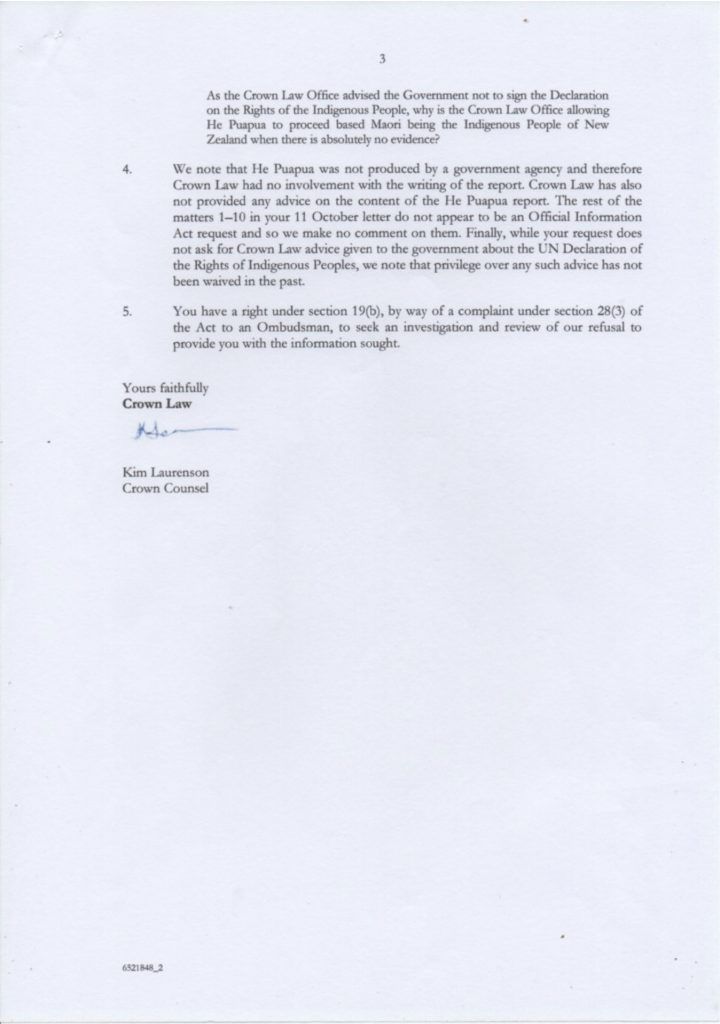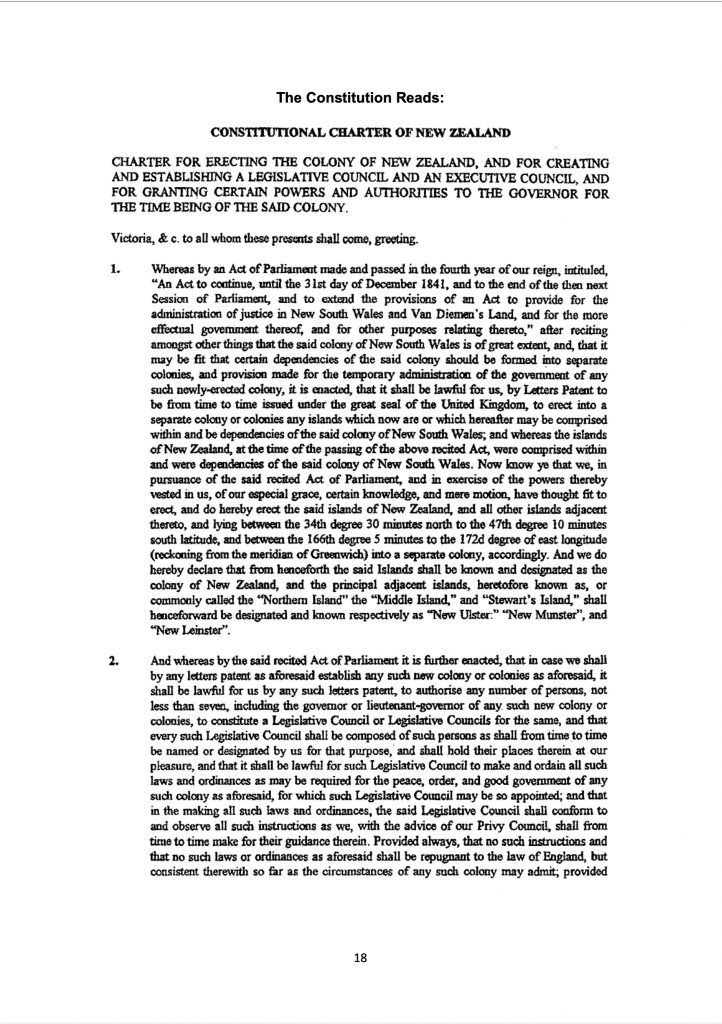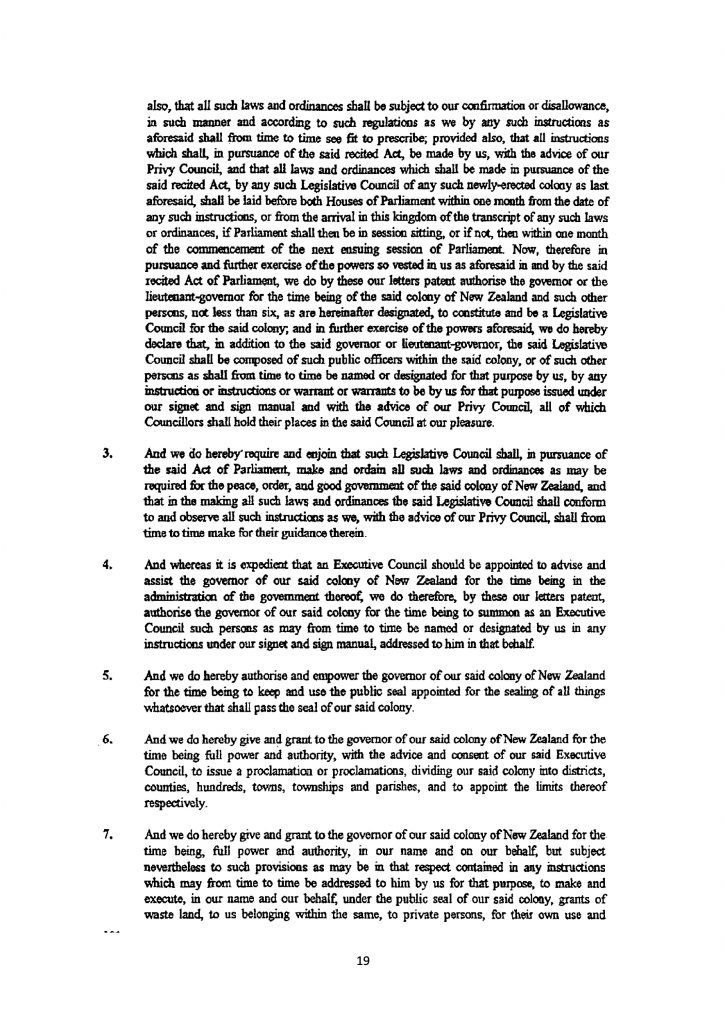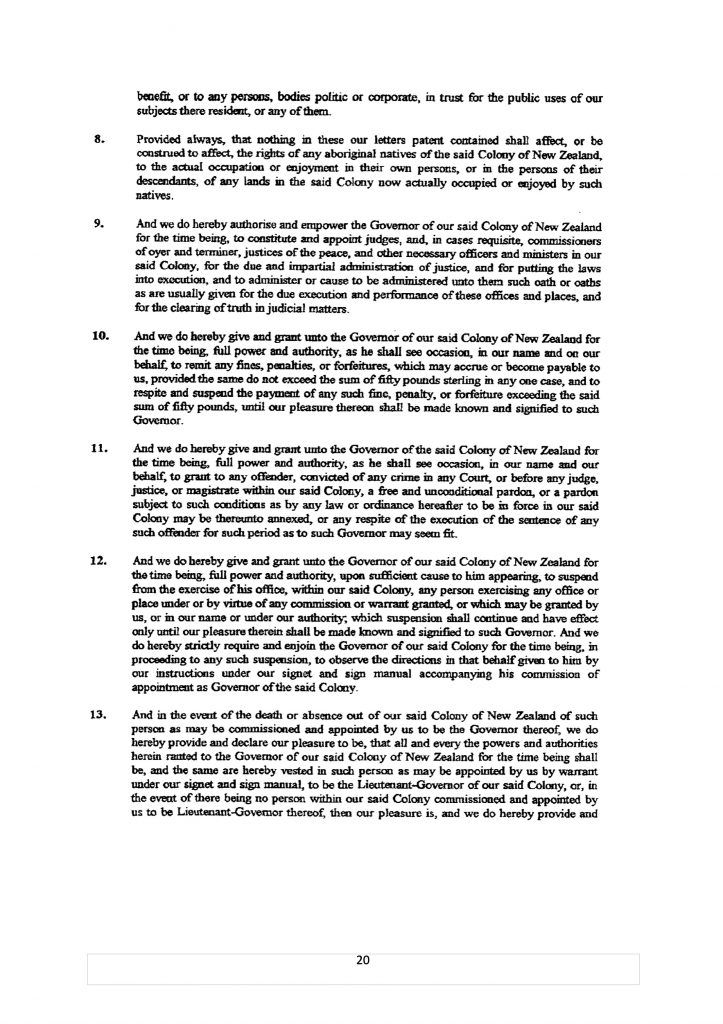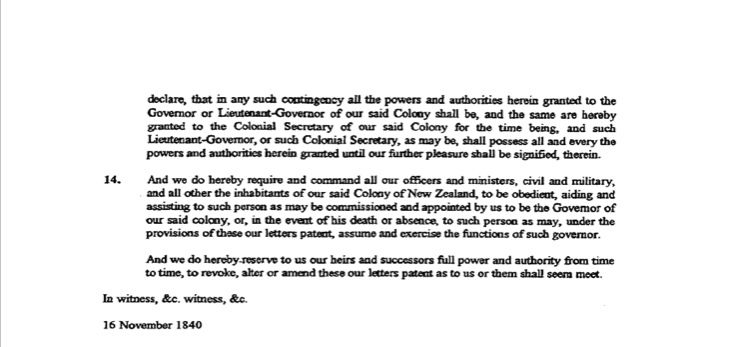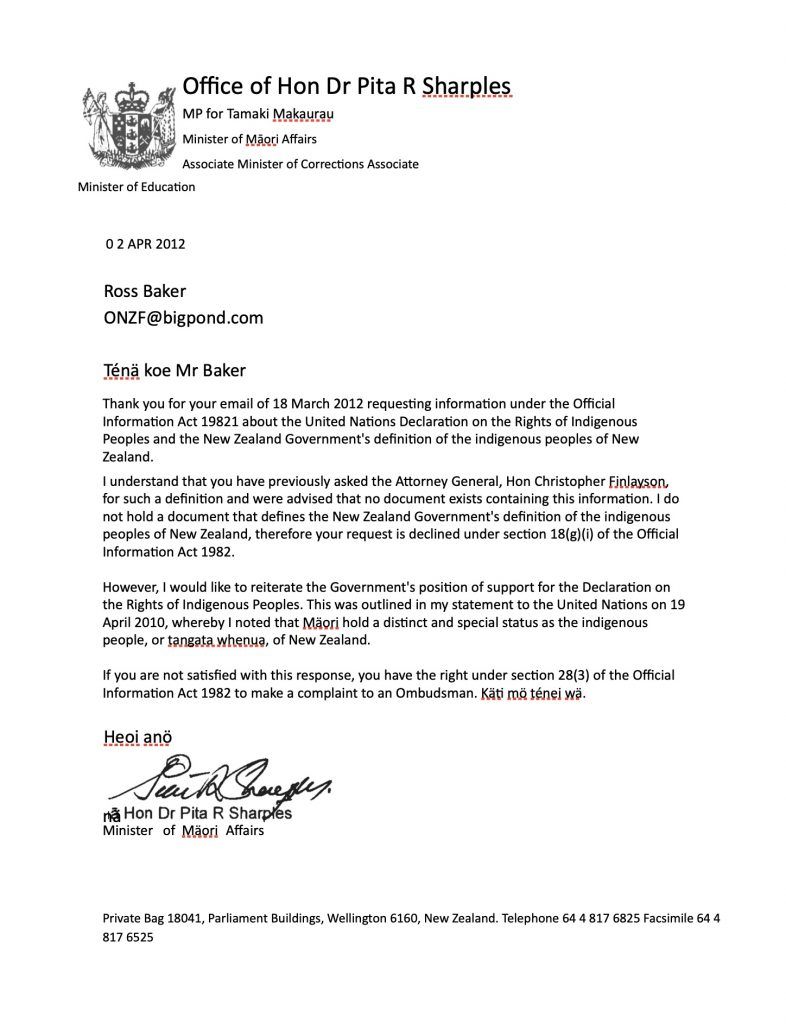Te Tiriti o Waitangi
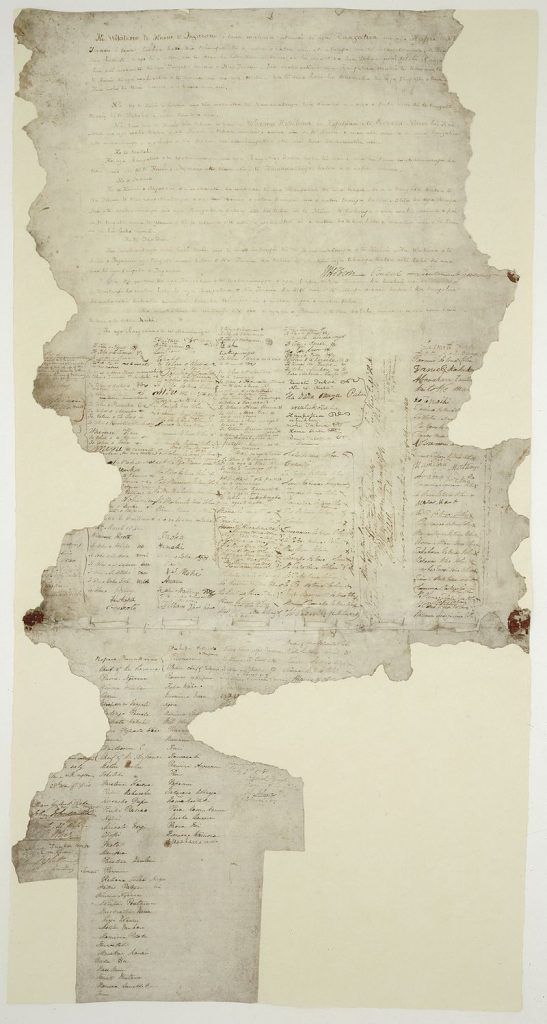
Superseded By Queen Victoria’s Royal Charter

New Zealand’s True Founding Document and first Constitution.
A Politician’s guide to New Zealand’s true documented history held in New Zealand, Australian and American Archives plus the British Parliamentary Papers and Letters obtained under the OIA.
Researched and written by the One New Zealand Foundation Inc. Est: 1988.
New Zealand’s True Documented History
It is hard to believe how our governments, researchers and historians, such as Michael King, Dame Claudia Orange, Dr Paul Moon, T Lindsay Buick, and hundreds of others have missed our true Founding Document and first Constitution as it’s been around since 16 November 1840. In fact, it was displayed in New Zealand Archive’s Constitution Room, Wellington until the One New Zealand Foundation Inc. brought it to the Government’s attention in 2015 and the Constitution Room was immediately dismantled, and the Royal Charter hidden in Archives repository amongst the other 6 million historical documents. The Royal Charter/Letters Patent must now be ordered to research, that is, if future researchers know it exists. Do you? The Treaty of Waitangi was then placed in the $7.2 million He Tohu Exhibition at the National Library, Wellington as, “An iconic constitutional document that shaped Aotearoa New Zealand”.
The Treaty of Waitangi was not a constitutional document and had nothing to do with forming a Government in New Zealand. In fact, it has done more to destroy New Zealand than any other document on record through the outrageous and unfounded translations and interpretations by Maori, the Government, and the Waitangi Tribunal. But no more so than when Attorney General, Hon Geoffrey Palmer dreamt up and passed into legislation, “The Five Principles for Crown Action on the Treaty of Waitangi”, destroying the true meaning and interpretation of the Treaty of Waitangi. He later admitted in his book, New Zealand’s Constitution in Crisis, page 89, “I was wrong”, but he never tried to correct his error, in fact, he helped Maori with their alleged claims against the Crown.
The Treaty of Waitangi asked the tangata Maori, not the tangata whenua as they had long gone, to give up their individual kawanatanga/governments to the Queen and in return, they would become British Subjects with the same rights as the people of England. Tangata Maori could not give up sovereignty as Chief Justice Sir James Prendergast explained in 1877, “So far indeed, as that instrument (The Treaty of Waitangi) purported to cede sovereignty, it must be regarded as a ‘simple nullity’. No political body existed capable of making cession of sovereignty”.
Once the Chiefs had given up their governments to the Queen and become British Subjects, the Treaty had achieved its purpose and was filed away. From 30 July 1839 until 3 May 1841, New Zealand was under the jurisdiction and dependency of New South Wales.
New Zealand’s true Founding Document and first Constitution
On 16 November 1840 a Royal Charter/Letters Patent was issued by “Victoria by the Grace of God” under “The Great Seal of the United Kingdom of Great Britain and Ireland”, which superseded the Treaty of Waitangi. The Royal Charter separated New Zealand from New South Wales on 3 May 1841 and made New Zealand into a British Colony with a Governor and Constitution that set up New Zealand’s political, legal and justice systems under one flag and one law, irrespective of race, colour or creed.
The Royal Charter/Letters Patent consisted of, “A Constitutional Charter for Creating and Establishing a Legislative Council and an Executive Council, and for Granting Certain Powers and Authority to the Governor for the time being of the said Colony”. All under one flag and one law, irrespective of race colour or creed.
Governments over the years have completely ignored Queen Victoria’s 1840 Royal Charter/Letters Patent, New Zealand’s true Founding Document and first Constitution. This has allowed the Treaty of Waitangi to be taken as New Zealand’s Founding Document when in fact, it had absolutely nothing to do with New Zealand becoming a British Colony or setting up our political, legal or justice system under one flag and one law, irrespective of race colour or creed.
There is no other document in New Zealand’s history that comes anywhere near to a Founding Document, than Queen Victoria’s 1840 Royal Charter/Letters Patent!
Timeline of New Zealand’s True History
All the information below is held in Zealand, Australian and American Archives, plus the British Parliamentary Papers, not from the minds of people who show little or no gratitude to the people of Britain for saving their tangata Maori ancestors from total extinction by their own hand!
1350 – The tangata Maori arrived in New Zealand by canoe to find New Zealand already inhabited by the tangata whenua. “The traditions are quite clear on one point, whenever crew disembarked there were already tangata whenua (Prior inhabitants) living in New Zealand”. Dr Ranginui Walker, Head of Maori Studies, Auckland University, 1986. Before the tangata Maori arrived in New Zealand there had been many other people living in New Zealand; the Turehu, Patupaiarehe and the Moriori, but it was the tangata Maori who signed the Treaty of Waitangi in 1840, not the tangata whenua or prior inhabitants as they had long gone by 1840.
1600 – The Moriori, a peace-loving people, were the last to be driven from New Zealand by the tangata Maori and settled in the Chatham Islands. Unfortunately, there is no record of what happened to other earlier people, although Maori legend tells, they were a light skinned people with red or fair hair and were driven into the hills and disappeared.
1642 – Abel Tasman was the first European to sight New Zealand on 13 December.
1769 – Captain James Cook sighted the East Coast of New Zealand on 6 October 1769.
1800 – European Whalers and Sealers set up stations on New Zealand shores.
1807 – Between 1807 and 1840 there were over 150 intertribal wars in New Zealand that killed over half the tangata Maori population. From 1820 on, they were known as the “Musket wars”
1814 – Rev Samuel Marsden arrived in New Zealand to bring Christianity to the tangata Maori.
1815 – Congress of Vienna. European powers agreed that New Zealand would belong to Britain, according to the Book of Dates.
1820– Hongi Hika travelled to England and returned with over 500 muskets. Ngapuhi then went on a rampage south killing thousands of their unarmed countrymen, women and children. This was known as the “Musket wars”
1831 – Ngapuhi afraid the Southern tribes, now armed with muskets, were about to attack for utu/revenge. Thirteen Ngapuhi chiefs wrote to King William IV asking him to be their guardian and protector. “We are a people without possessions (taonga). We have nothing but timber, flax, pork, and potatoes, we sell these things, however to your people, and then we see the property (taonga) of your people. It is only thy land, which is liberal towards us. We have heard that the tribe of Marian (France) is at hand coming to take away our land, therefore we pray thee become our friend and the guardian of these islands, lest the teasing of other tribes should come near us, and lest strangers should come and take away our land”.
1831 – The Waikato attacked Taranaki, slaughtering one third, taking one third as slaves, and the rest fleeing to Wellington. Taranaki was deserted, but under the watchful eye of Waikato.
1832 – The British Colonial Office decided to appoint James Busby as British Resident in New Zealand. Later named by the tangata Maori as, “A man of war without guns”.
1834 – James Busby held a meeting with 25 northern chiefs in March 1834 to select a flag for New Zealand. A flag already used by the Church Missionary Society was selected.
1835 – Busby believed that a French eccentric, Baron Charles de Thierry was part of a French plot to annex New Zealand, so he decided to declare New Zealand independent on 28 October 1835 under the sovereignty of the United Tribes of New Zealand. Busby presented the Declaration of Independence to the chiefs but could only entice 39 chiefs to sign it before it was abandoned due to the continuing inter-tribal fighting. It became obvious to Britain, the chiefs did not have the ability or will to form a united government to bring law, order, peace or trade under one sovereignty to a country completely out of control.
1835 – Some of the Taranaki tribes that had fled to Wellington commandeered the ship Rodney and in two trips, 19 November and 5 December 1835, invaded the Chatham Islands, slaughtering or farming the peace-loving Morori “like swine” into virtual extinction.
1837 – Captain William Hobson visited New Zealand. Hobson recommended that British sovereignty apply to small areas where British commercial enterprises could be established, with taxes levied and British law applying to those living there, and some sort of treaty to gain Maori permission.
1838 – During April and May, a Select Committee of the British House of Lords considered options for New Zealand. Its report recommended concluding a treaty with tangata Maori as part of a policy to extend British rule over New Zealand and to give the tangata Maori protection.
1839 – The New Zealand Company concluded a Deed of Purchase of Port Nicholson (Wellington) on 29 September with the tangata Maori, forcing the British government to intervene. Over two thirds of New Zealand, virtually all the South Island had been sold by the chiefs before 1840 with many of the Deeds of Sale still held in the New South Wales Supreme Court. The Colonial Secretary for Colonies, Lord Normanby issued instructions, written by the Under Secretary for Colonies, Sir James Stephens to Hobson for a Treaty with the tangata Maori on 14 August 1839. The first New Zealand Company colonists arrived at Petone on 22 January 1840.
1840 – Hobson arrived in New Zealand on 29 January 1840 and issued 2 Proclamations on 30 January 1840. (1). He was to become Lt. Governor to New Zealand and New Zealand would become a dependency of New South Wales under Governor Gipps. (2). No existing land titles in New Zealand would be recognised as valid unless confirmed by the Colonial Government.
1840 – Hobson began to draft the Treaty of Waitangi on 1 February from the instructions he had been given by the Secretary for Colonies, Lord Normanby, but fell ill on 2 February and Busby completed a Treaty draft on 3 February. Hobson made changes and Busby completed the final draft on 4 February under Hobson’s direction. Rev Henry and son Edward Williams translated the Treaty’s final draft into the tangata Maori language, Te Tiriti o Waitangi, on the night of 4 February.
On 5 February Hobson and Williams read the final English draft of the Treaty and the Tiriti o Waitangi to the chiefs gathered at Waitangi. The text was extensively discussed and debated by the chiefs, Hobson and Missionaries, then later, well into the night. While the signing was to take place on 7 February, it was decided by the chiefs to sign it on 6 February to Hobson’s surprise.
On 6 February forty-nine chiefs signed the Tiriti o Waitangi at Waitangi. Tangata Maori were to give up their individual kawanatanga/governments to Queen Victoria and in return, tangata Maori were given, “The same rights as the people of England”. Queen Victoria did not have the power or authority to give Maori any special rights in the Tiriti o Waitangi not already enjoyed by all the people of England under English Law. “The chiefs placed in the hands of the Queen of England, the Sovereignty and authority to make laws”, Sir Apirana Ngata, Minister of Maori Affairs 1928 – 1932.
The New South Wales Continuance Act pronounced the Islands of New Zealand to be under the jurisdiction New South Wales and was passed in Britain on August 7, 1840.
The Proclamations of British sovereignty over all the islands of New Zealand appeared in the London Gazette on 2 October 1840.
A total of 512 chiefs, including 13 women, signed the nine copies of the Treaty of Waitangi, all except one in the Maori language text, at 34 locations around New Zealand between 6 February and 17 June 1840. Only 39 chiefs signed an unauthorised English language version when the CMS printed copy of the Tiriti o Waitangi could hold no more signatures. Hobson never made or authorized an English version of the Treaty of Waitangi, stating to those gathering further signatures after he became ill, “The treaty which forms the base of all my proceedings was signed at Waitangi on 6 February 1840, by 52 chiefs, 26 of whom were of the federation, and formed a majority of those who signed the Declaration of Independence. This instrument I consider to be de facto the treaty, and all signatures that are subsequently obtained are merely testimonials of adherence to the terms of that original document”. Note: No English version was signed at Waitangi on 6 February 1840.
The Treaty of Waitangi had achieved it purpose and was filed away; the tangata Maori had given up their individual governments to the Queen and had become British Subjects with the same rights as the people of England under the dependency of New South Wales. No more, no less.
New Zealand’s true Founding Document and first Constitution
1840 – The Treaty of Waitangi was superseded by Queen Victoria’s Royal Charter/Letters Patent dated 16 November 1840. The Constitutional Charter of New Zealand, “Enacted the Colony of New Zealand and Created and Established a Legislative Council, an Executive Council and for Granting Certain Powers and Authority to the Governor for the time being of the said Colony”.
1841 – On 3 May, Lt. Governor Hobson took the oath as Governor and Commander in Chief. New Zealand became a British Crown Colony and was no longer under the jurisdiction of New South Wales. The Governor summoned an Executive Council to advise and assist him. This Council comprised the Colonial Secretary, the Attorney-General, and the Treasurer. A Legislative Council of seven people – the Governor, the members of the Executive Council, and three nominated Justices of the Peace were to make laws and ordinances “for the peace, order, and good government” of the Colony. The Executive and Legislative Councils met frequently during the governorships of Hobson and his successors, with Lieutenant Willoughby Shortland (as Administrator). Throughout the Crown Colony period, each Governor held, in the name of the Crown, complete control over the executive and legislative functions of government under the watchful eye of the British Parliament.
1841 – Hobson presided over the first sitting of the Legislative Council on 24 May 1841. He cited the Royal Charter dated 16 November as the authority for him to assume the position of Governor and Commander-in-Chief and to appoint an Executive Council. George Clarke became Chief Proctor of the tangata Maori.
1842 – Claims Commissioners investigated all land purchases made before the signing of the Treaty of Waitangi. If the commissioners concluded that a purchase was made in good faith, they could validate it and award a Crown Grant of up to 4 square miles (1037 ha). If the purchase was invalid or exceeded that size, the land was returned to the seller or became Crown land. Commissioner William Spain investigated the huge purchases claimed by the New Zealand Company. He determined that most of those in Wellington and elsewhere were invalid, but not all his recommendations were acted upon.
1844 – The Governor paid Waikato for Taranaki and allowed those who had fled to Wellington or had become slaves to return to their homeland. The Taranaki tribes began fighting amongst themselves as well as killing innocent settlers, their families and destroying their farms. While these have been called, “Land wars”, the Imperial Troops were brought in to only gain peace with the “rebels”. The Waikato also became involved in the disturbances in Taranaki with land being confiscated to pay for the troops, although much of this land was returned. “Some have said that these confiscations were wrong, and they contravened the articles of the Treaty of Waitangi, but the chiefs placed in the hands of the Queen of England, the Sovereignty and authority to make laws. Some sections of the Maori people violated that authority, war arose, and blood was spilled. The law came into operation and land was taken as payment. This in itself is Maori custom – revenge – plunder to avenge a wrong. It was their chiefs who ceded that right to the Queen. The confiscations cannot therefore be objected to in the light of the Treaty”. Sir Apirana Ngata, Minister of Maori Affairs, 1928 – 1932. The people of Parihaka, which was built on confiscated land in 1866, were continually interfering with the Government surveyors and the settler’s farms and were asked to stop by the Imperial Troops without a shot being fired. After a trial in New Plymouth, the leaders were jailed in the South Island for 2 years.
1846 – The New Zealand Constitution Act 1846 was an Act of the Parliament of the United Kingdom, “To make further provision for the Government of the New Zealand’s Islands. It received the Royal Assent on 28 August but was never fully implemented.
1852 – The New Zealand Constitution Act 1852 was an Act of the Parliament of the United Kingdom that, “Granted self-government to the Colony of New Zealand”. The Act remained in force as part of New Zealand’s constitution until it was repealed by the Constitution Act 1986.
1853 – NZ’s first election for its own government. 5849 registered voters chose 37 MPs.
1854 – The first Parliament met in Auckland in May, regarded as an experiment in constitutional government since it was one of the first examples of substantial colonial self-rule in the British Empire.
1860 – About 200 Maori chiefs met at Kohimarama, Auckland, in July 1860 to discuss the Treaty of Waitangi. Governor Thomas Gore Browne had convened the conference. The Chiefs at the Kohimarama Conference unanimously declared, “Recognition of the Queen’s Sovereignty and the union of the two races”.
1907 – Colony of New Zealand was replaced with Dominion of New Zealand.
1930 – -Many of the claims by Maori against the Crown were heard by the Courts with “Full and
Final Settlements” or rejected between 1930 and 1940.
1947 – New Zealand adopted the Statute of Westminster. The Statute granted complete autonomy to New Zealand in domestic as well as foreign affairs. All the people of New Zealand became New Zealand Citizens under one flag and one law, irrespective of race, colour or creed. The Reigning Monarch became our Head of State.
1949 – Passports for all New Zealanders changed from British Subjects to New Zealand Citizens.
1970– Many of the “full and final” Land Settlements were coming to an end and Maori were approaching Government for ways to open the claims process again.
1975 – The Government enacted the Treaty of Waitangi Act that created the Waitangi Tribunal. A Tribunal funded by government to assist and hear claims by Maori that may occur after 1975. The Tribunal was given the sole rights to interpret the Treaty of Waitangi. Non-Maori could not lay a claim, participate, or appeal a claim or a recommendation by the Waitangi Tribunal to Government.
1985 – The Government decided in 1985 to amend the Treaty of Waitangi Act to allow claims dating back to 1840 to be heard by the Waitangi Tribunal including those that had already had “full and final settlements” or rejected in 1830/40. This opened a flood gate of claims to the sympathetic Waitangi Tribunal which now interpreted the Treaty to suit the claim. The Minister of Treaty of Waitangi Negotiants, Hon Christopher Finlayson was also settling claims in secret, claiming, he gave away taxpayer’s money in more Maori financial settlements than all previously reached, 59 in all.
1986 – Attorney General, Hon Geoffrey Palmer’s dreamt up “Five Principles for Crown Action on the Treaty of Waitangi” began to appear in Treaty recommendations and Legislation. There were no Principles in the Treaty of Waitangi, tangata Maori gave up their governments and became British Subjects. No more – no less! Palmer latter admitted in his book, New Zealand’s Constitution in Crisis, page 89, “I was wrong”.
1987 – The Treaty of Waitangi was now being referred to as, “A Partnership between Maori and the Crown”, but the Treaty only gave Maori, “The same rights as the people of England” and the people of England could not be in partnership with the Crown.
2007 – Prime Minister, Hon Helen Clark asked the Crown Law Office for advice whether she should sign the Declaration on the Rights of Indigenous People. The Crown Law Office advised her, “Not to sign it as it contradicted our Constitution of one flag and one law, irrespective of race colour or creed”.
2010 – Prime Minister, Hon John Key completely ignored the advice from the Crown Law Office and sent Hon Pita Sharples to New York on 19 April 2010 to sign the Declaration on the Rights of Indigenous People, without advice from the Crown Law Office, a mandate from Parliament or a definition of who were the Indigenous People of New Zealand.
2014 – One New Zealand Foundation Inc researched Queen Victoria’s 1840 Royal Charter/Letters Patent and found it was New Zealand’s true Founding Document and first Constitution and brought this information to the Government’s and public’s attention.
2017 – The Government immediately dismantled the Constitution Room at Archives New Zealand where the Royal Charter was held and hid it in Archive repository out of the public’s sight.
2017 – Government spent $7.2 million on the He Tohu Exhibition at the National Library, Wellington to display the Treaty of Waitangi as, “An iconic constitutional document that shaped Aotearoa New Zealand”. The most corrupt act ever enforced on the People of New Zealand by any Government; to hide our true Founding Document and first Constitution.
Conclusion
Signing the United Nations Declaration on the Rights of Indigenous People opened the door for “Maori to be in Partnership with the Crown” and “Maori to Co-Govern with the elected Government of New Zealand”, when Maori are only 15 % of the population and not indigenous to New Zealand.
The Treaty of Waitangi made the tangata Maori British Subjects with the same rights as the people of England and the 1840 Royal Charter placed all the people of New Zealand under one flag and one law, irrespective of race, colour or creed. At no time did the Treaty of Waitangi, the Royal Charter or English Law give Maori rights not enjoyed by all the People of England/New Zealand.
This booklet has been produced for New Zealand’s Politicians who it is obvious, have never researched New Zealand’s true history. Surely, they have asked themselves, “How did New Zealand become a British Colony with a Governor and Constitution that set up our political, legal and justice system”? You don’t have to be very bright to know it was not the Treaty of Waitangi, it could only have been Queen Victoria’s Royal Charter/Letters Patent dated 16 November 1840.
The information above has been sourced from New Zealand, Australian and American Archives,
plus, the British Parliamentary Papers, not from the minds of people who show little gratitude to the people of Britain who saved their tangata Maori ancestors from total extinction by their own hand!
There is no other document in New Zealand’s history that comes anywhere near to a Founding Document, than Queen Victoria’s 1840 Royal Charter/Letters Patent!
Can Our Politicians Fix It – Yes, They Can,
But Will They Have the Courage?
New Zealand’s leading Constitutional Law, Attorney General and later Prime Minister, Sir Geoffrey Palmer, who dreamt up and passed into legislation, “The Five Principles for Crown Action on the Treaty of Waitangi”, destroyed the true meaning and interpretation of the Treaty of Waitangi by those that signed in 1840. He later admitted in his 1992 book, New Zealand’s Constitution in Crisis, page 89, “I was wrong”, but he never tried to correct his errors, in fact, he continued helping Maori with their alleged claims against the Crown, cashing in on his “Five Principles” at the taxpayer’s expense!
On page 98 of this same book, he did give future Politicians a way to replace what he had destroyed when Attorney General!
“It is true the Treaty of Waitangi Act 1975 and all the other statutes, which give explicit recognition to the Treaty are not entrenched. They can be swept away by a simple majority in Parliament”.
Surely by now, our Politicians can see that New Zealand’s Democracy has been completely destroyed since the 1975 Treaty of Waitangi Act was enacted that created, “The Waitangi Tribunal”, “The Five Principles”, “A Partnership between Maori and the Crown” and the latest, Jacinda Ardern and Nanaia Mahuta “two illegitimate babies”, “Three Waters”, and “He Puapua”, (“A Co-governance” with the constitutionally elected government of New Zealand).
Since this time, Maori have pulled the wool over the Politician’s eyes because the Politician’s had no idea of New Zealand’s true history. They believed Maori were the indigenous people of New Zealand and the Treaty of Waitangi was our Founding Document, when in fact, both are fiction.
From the above history held in New Zealand, Australian and American Archives, plus the British Parliamentary Papers and Official Information Act letters from Ministers of the Crown over a number of years, Maori are not the indigenous people of New Zealand, and the Treaty of Waitangi only asked the tangata Maori to give up their kawanatanga/governments to the Queen and in return, they would become British Subjects with the same rights as the people of England. No more, no less!
How did our Politicians allow 15% of the population, who claim a minute trace of tangata Maori ancestry gain such power? It was very simple; our Politicians have been either too lazy to research our true history, too afraid to rock the boat or wanted to stay in power by giving in to Māori’s every demand. They have completely ignored the other 85% of New Zealand Citizens.
Hon Geoffrey Palmer has given our Politicians an out for all the errors they have made over the last 47 years, but have they got the courage, “To sweep it all away by a simple majority in Parliament” and “Treat Maori as New Zealand Citizens”, “Abolish the 1975 Treaty of Waitangi Act”, delete “The Five Principles”, “The Partnership between Maori and the Crown” and “He Puapua”.
The Politicians have no excuse now, they have the true documents history of New Zealand in this booklet but have they the courage to do what is right for New Zealand and its People in the next election.
Hopefully, the polling booths will show at last we have Politicians with courage, not the wimps we have had for the last 47 years who have destroyed New Zealand’s democracy and breached our Constitution of one flag and one law, irrespective of race colour or creed!
Donations gratefully accepted to print more copies of the booklet. Please deposit donation into our Bank Account: ANZ 010338-0046989-00. Become a member of ONZF: http://onenzfoundation.co.nz/membership/
Queen Victoria’s 1839 Royal Charters/Letters Patent
Below is the ‘Charter/Letters Patent’ appointing William Hobson as Lieutenant Governor of New Zealand and extending the boundaries of New South Wales to include all the islands of New Zealand in 1839. Sir George Gipps, Governor of New South Wales was in fact, the first Governor of New Zealand with Captain William Hobson as his Lieutenant.
1839 Charter/Letters Patent for New Zealand and New South Wales

The Royal Charter/Letters Patent reads,
Victoria R
Victoria by the Grace of God of the United Kingdom of Great Britain and Ireland Queen, Defender of the Faith – To Our Trusty and Well beloved, William Hobson Esquire, Captain of the Royal Navy Greeting. Whereas We did by certain Letters Patent under the Great Seal of Our United Kingdom of Great Britain and Ireland bearing date at Westminster the 5th day of October 1837 in the First year of Our Reign constitute and appoint Our Trusty and Well beloved, Sir George Gipps, Knight, to be Our Captain General and Governor in Chief in and over Our Territory of New South Wales, comprised within the limits therein mentioned. And Whereas We did by certain other Letters Patent under the Great Seal of Our said United Kingdom, bearing date at Westminster the 15th day of June 1839 in the Third Year of Our Reign revoke so much of the said first recited Letters Patent as describes the limits of Our said Territory of New South Wales, and did further extend the limits of Our said Territory of New South Wales (subject to such exception as is therein particularly made of certain Territories now forming the Province of South Australia) from the Northern Cape or extremity of the Coast called Cape York in the latitude of 10 Degrees 37 Minutes South to the Southern extremity of the said Territory of New South Wales or Wilson’s promontory in the latitude of 39 Degrees 12 Minutes South and of all of the Country inland to the Westward as far as the 129th Degree of East longitude reckoning for the Meridian of Greenwich including all the Islands adjacent in the Pacific Ocean within the latitude aforesaid of 10 Degrees 37 Minutes South and 39 Degrees 12 Minutes South, and also including Norfolk Island lying in or about the latitude of 29 Degrees 3 Minutes South and 168 Degrees of East Longitude from the said Meridian of Greenwich, and also including any Territory which is or maybe acquired in Sovereignty by Us Our Heirs or Successors within that group of Islands in the Pacific Ocean commonly called New Zealand, and lying in or about the latitude of 34 Degrees 30 Minutes North and 47 Degrees 10 Minutes South, and 166 Degrees 5 Minutes and 179 Degrees East longitude from the said Meridian of Greenwich. Now Know you that We reposing especial Trust and Confidence in the Prudence Courage and Loyalty of you the said William Hobson do by these Present constitute and appoint you to be Our Lieutenant Governor in and over that part of Our Territory so described as foresaid in Our said last recited Letters Patent which is or maybe acquired in Sovereignty by Us Our Heirs or Successors within that group of Islands in the Pacific Ocean commonly called New Zealand, lying in or about the latitude of 34 Degrees 30 Minutes North and 47 Degrees 10 Minutes South, and 166 Degrees 5 Minutes and 179 Degrees East longitude reckoning from the Meridian of Greenwich. To have hold exercise and enjoy the said Office of Lieutenant Governor during Our Pleasure: And We do hereby command that in the execution of such your Office you do obey all such lawful Instructions as may be from time to time addressed to you by Our Trusty and Well beloved Sir George Gipps, Our Captain General and Governor in Chief in and over Our Territory of New South Wales and its Dependencies or in the event of his death or absence from the limits of his Government and command by the Officer for the time being administering the Government of Our said Territory and its Dependencies. And Whereas it is necessary that provision be made for the execution of the Office of Our Lieutenant Governor of Our said Territories in New Zealand in the event of your Death or absence therefrom, We do therefore by these Presents authorise and empower the said Sir George Gipps or the Officer Administering the Government of Our said Territory of New South Wales and its Dependencies for the time being to nominate and appoint by an Instrument under the Public Seal of Our said Territory of New South Wales, such person as he may think fit to act provisionally as Our Lieutenant Governor of Our said Territories in New Zealand in the contingency of such your Death or absence therefrom, or until other or further provision shall be made by Us in that behalf. And We do hereby give and grant to the Officer so to be provisionally appointed as aforesaid, during the continuance of such his authority full power to hold exercise and enjoy the said Office of Our Lieutenant Governor of Our said Territories in New Zealand as fully and in every respect as effectually as the same as is hereby vested in you, or may be by virtue hereof be held, exercised or enjoyed by you – Given at Our Court at Buckingham Palace the 30th day of July 1839, in the Third Year of Our Reign. By Her Majesty’s Command, Lord Normandy.
Above is the Royal Charter/Letters Patent dated 30 July 1839 issued by “Victoria by the Grace of God” under “The Great Seal of the United Kingdom of Great Britain and Ireland” that extended the boundaries and laws of New South Wales over all the islands of New Zealand. There is no mention of the Treaty of Waitangi in this Charter.
Below is Queen Victoria’s Royal Charter/Letters Patent dated, 16 November 1840. The Constitution of the Colony of New Zealand into a separate colony on 3 May 1841. Archives New Zealand Ref. No. ACGO 8341 1A1 9.
Royal Charter of 1840. Constitution of the Colony of New Zealand into a separate Colony 3 May 1841
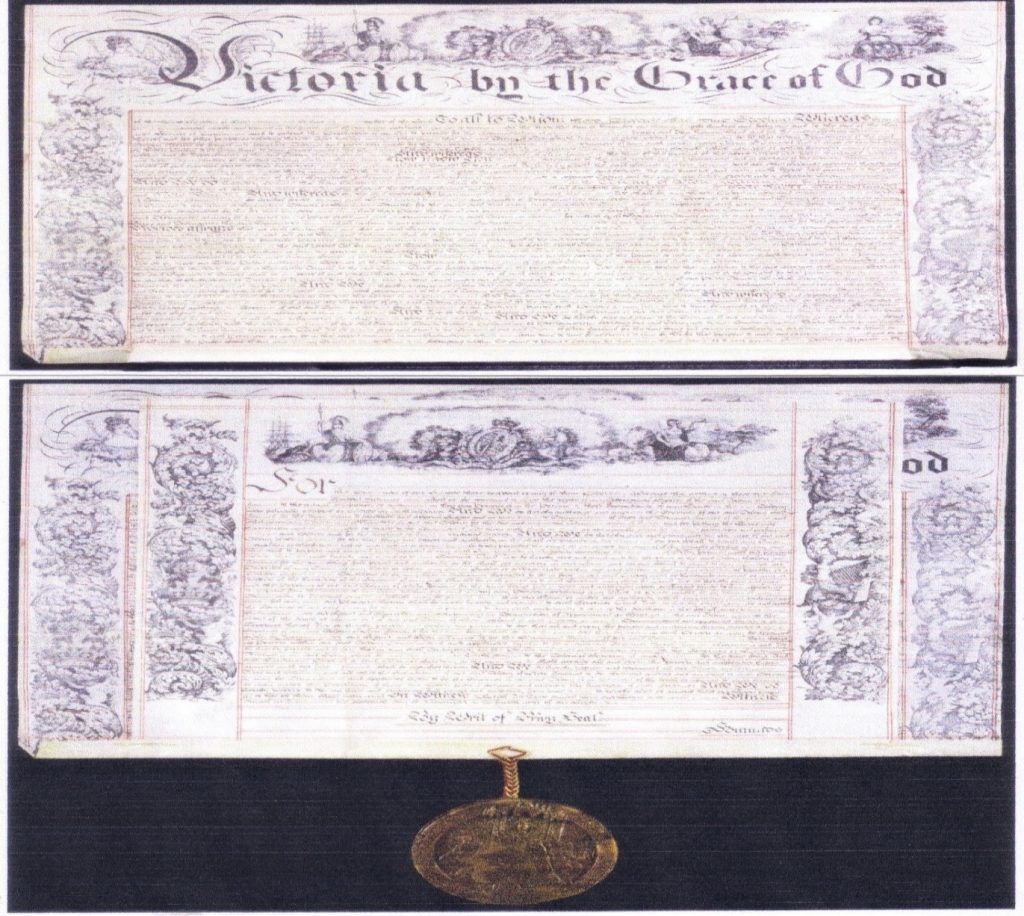
This is New Zealand true Founding Document and first Constitution
The Constitution Reads:
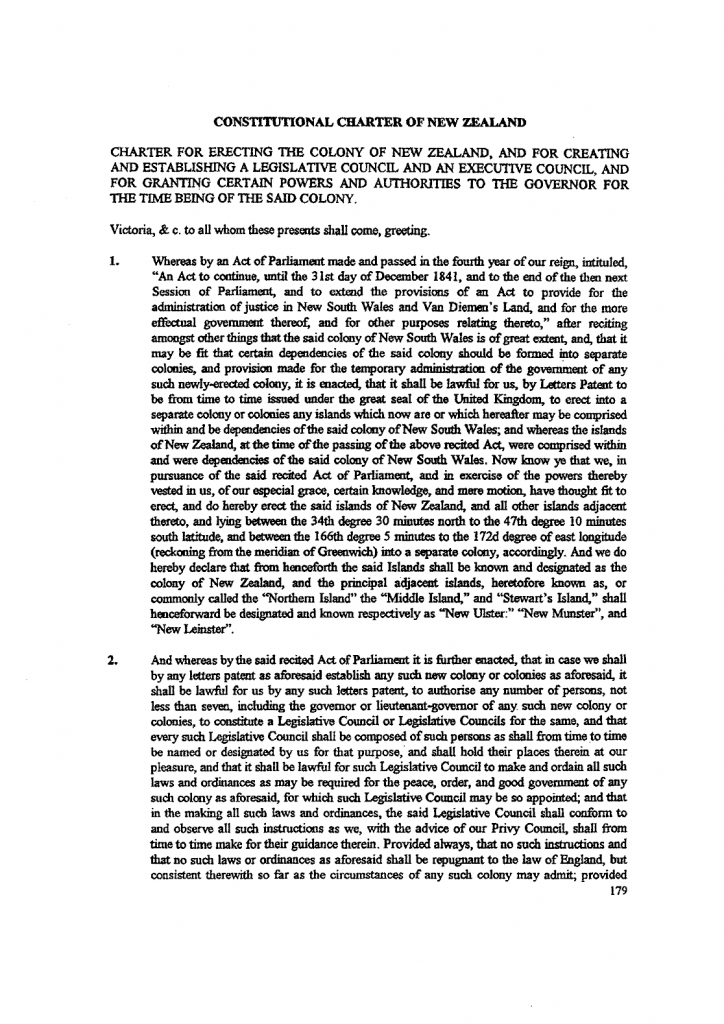

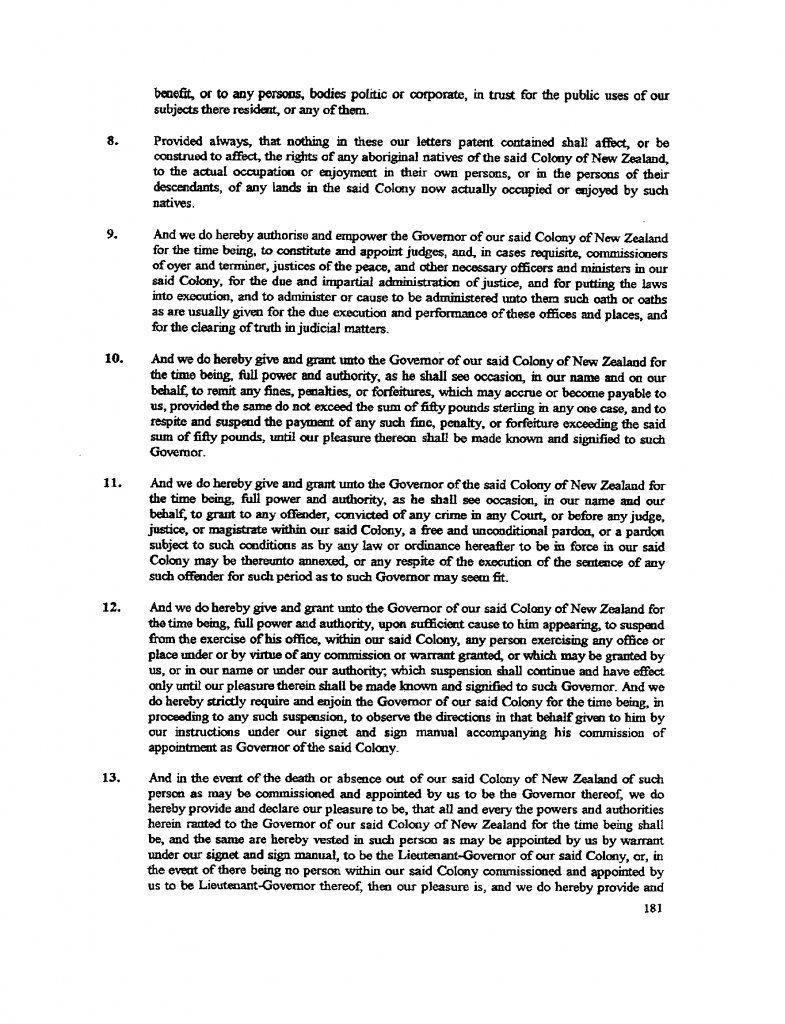
The Royal Charter/Letters Patent dated 16 November 1840 issued by “Victoria by the Grace of God” under “The Great Seal of the United Kingdom of Great Britain and Ireland” the only document that separated New Zealand from New South Wales and made New Zealand into a British Colony with a Governor and Constitution that set up New Zealand’s political, legal and justice systems under one flag and one law irrespective of race, colour or creed

“Charter of 1840. Constitution of the Colony of New Zealand into a separate colony, 16 November 1840”
Disc supplied by the Chief Archivist, Archives New Zealand.
Sir Apirana Ngata, Minister of Native Affairs M.A.,LI.B, Lit.D, 1922, “Let me issue a word of warning to those who are on the habit of bandying the name ot Treaty around to very careful lest it be made the means of incurring certain liabilities under the law which we do not know now and which are being borne only by the Pakeha” It is obvious he was referring to Queen Victoria’s 1840 Royal Charter.
Prepared by Ross Baker, Researcher, One New Zealand Foundation Inc. 1/1/2022 (C).
For further information: www.onenzfoundation.co.nz. OR Email: ONZF@bigpond.com.au












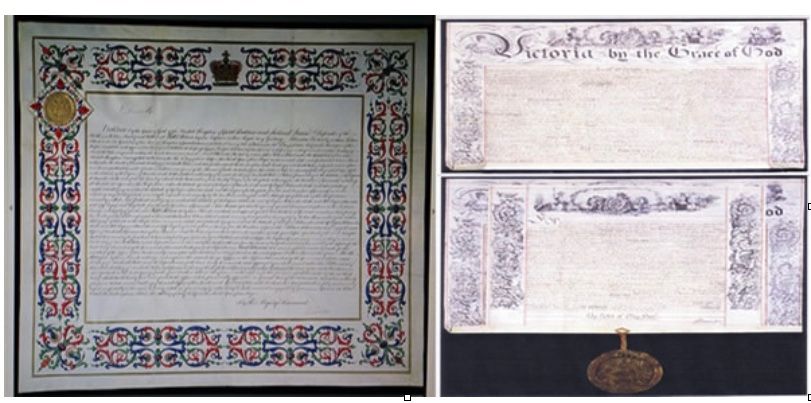
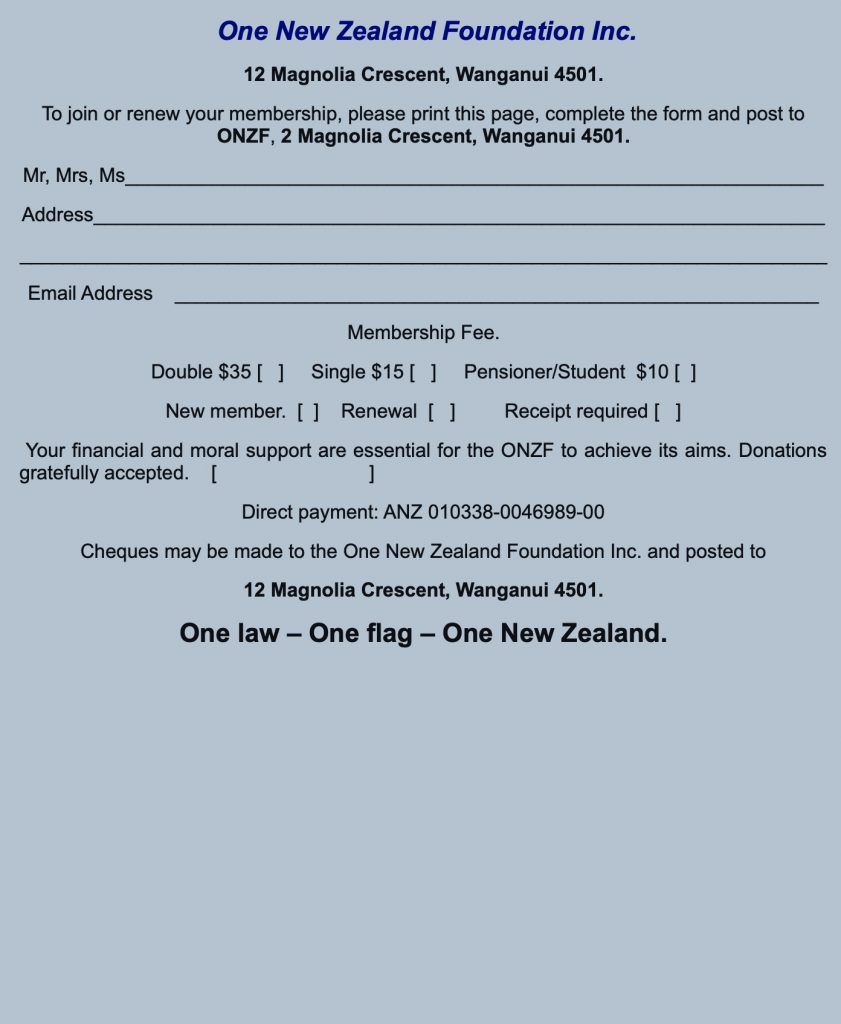
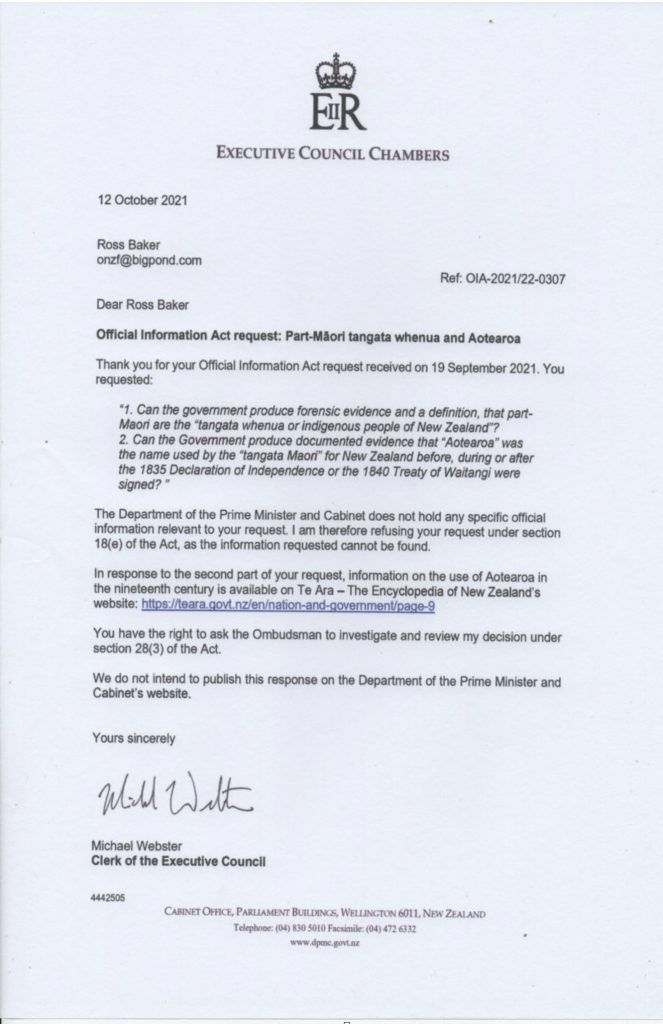
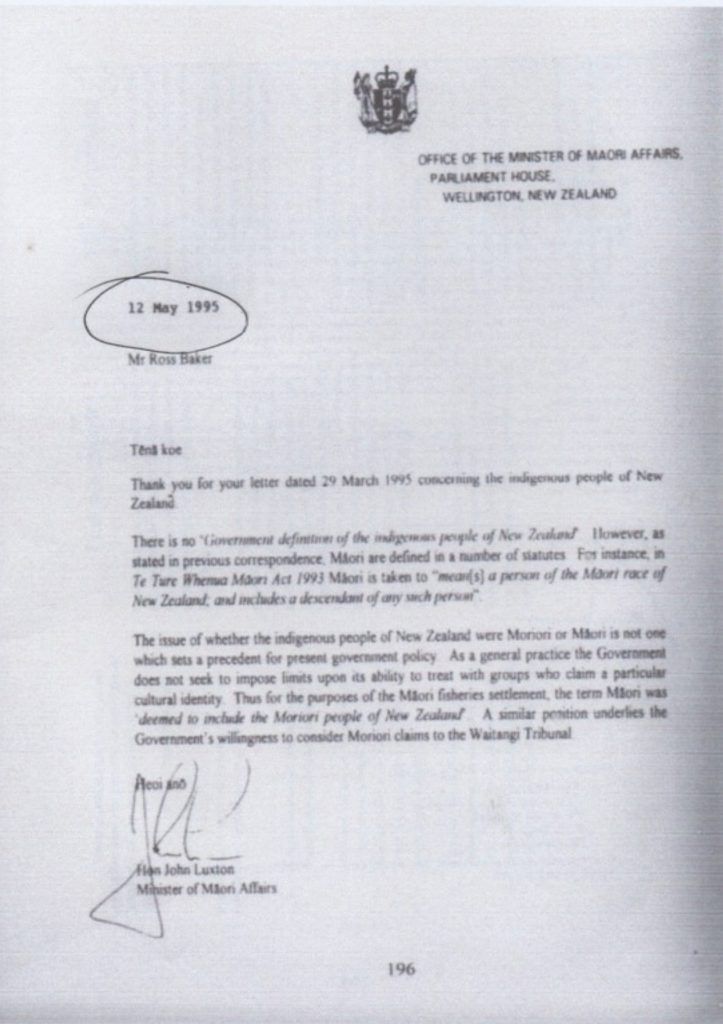
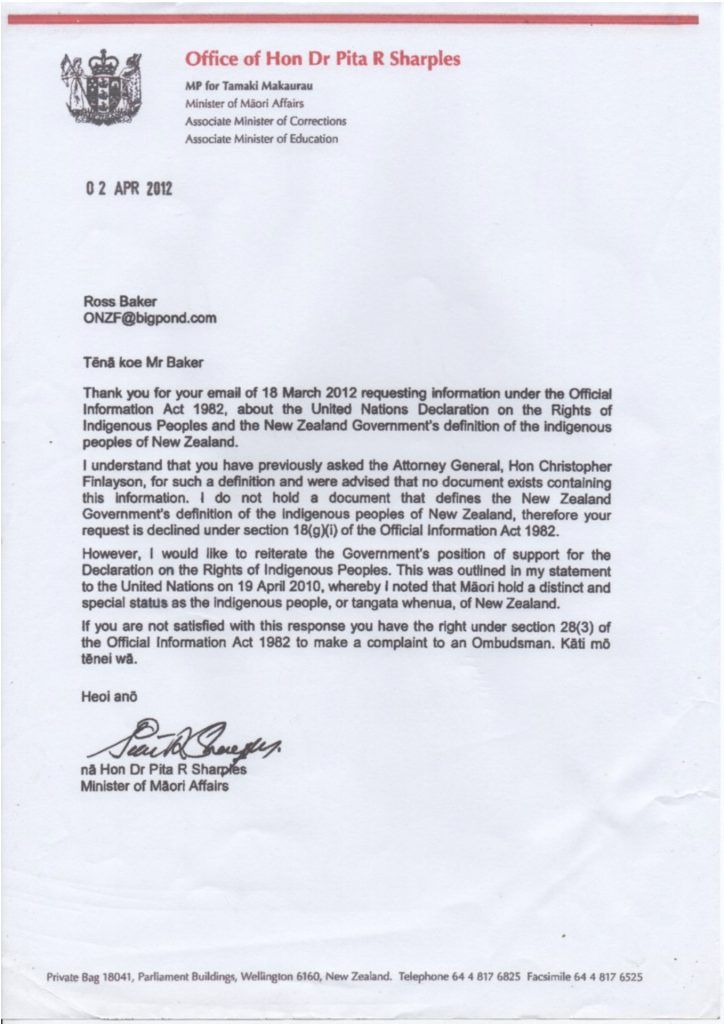
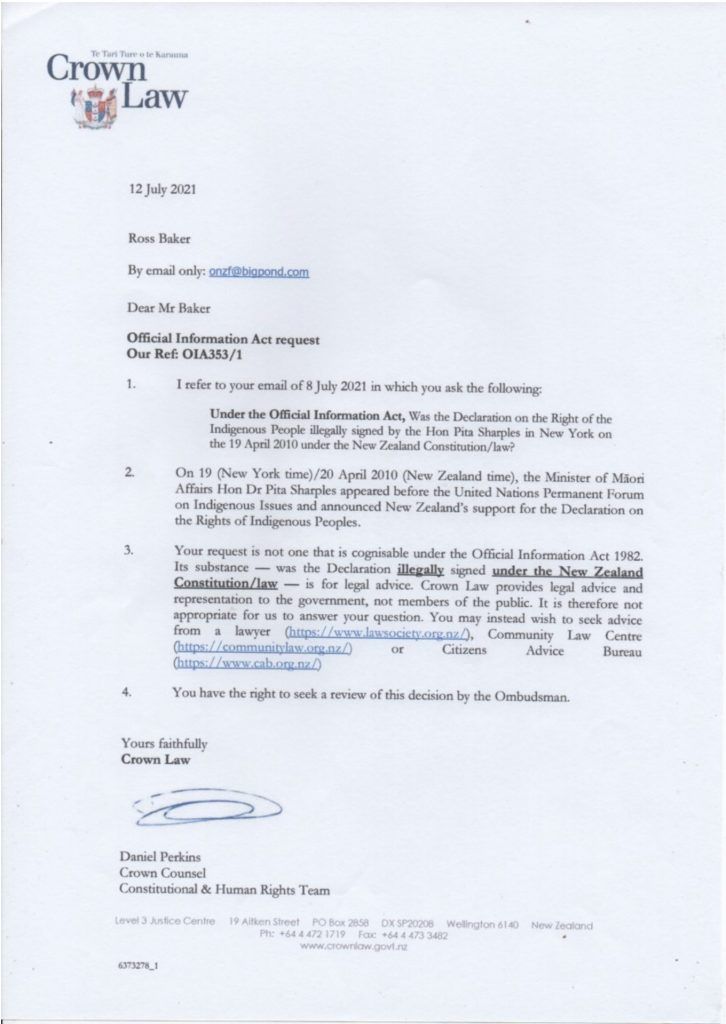
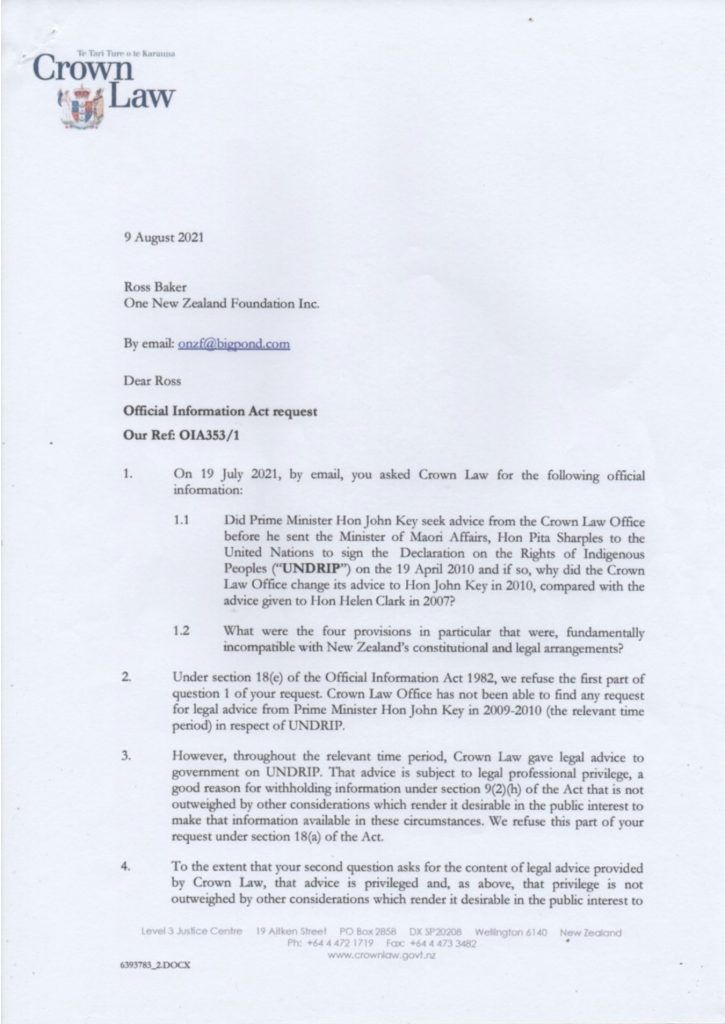
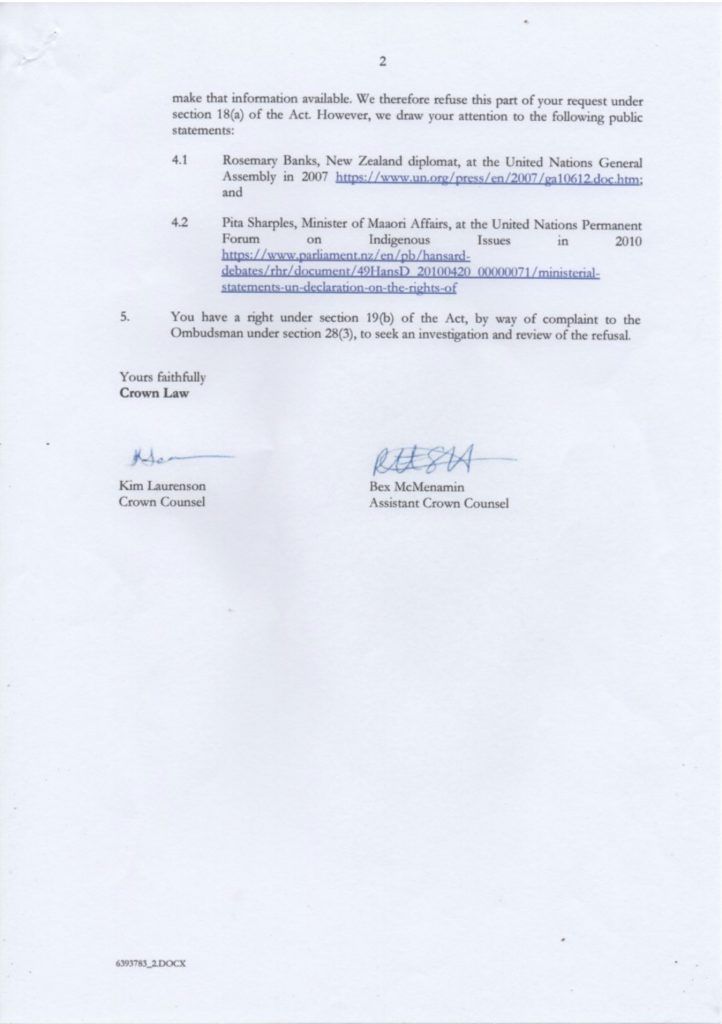
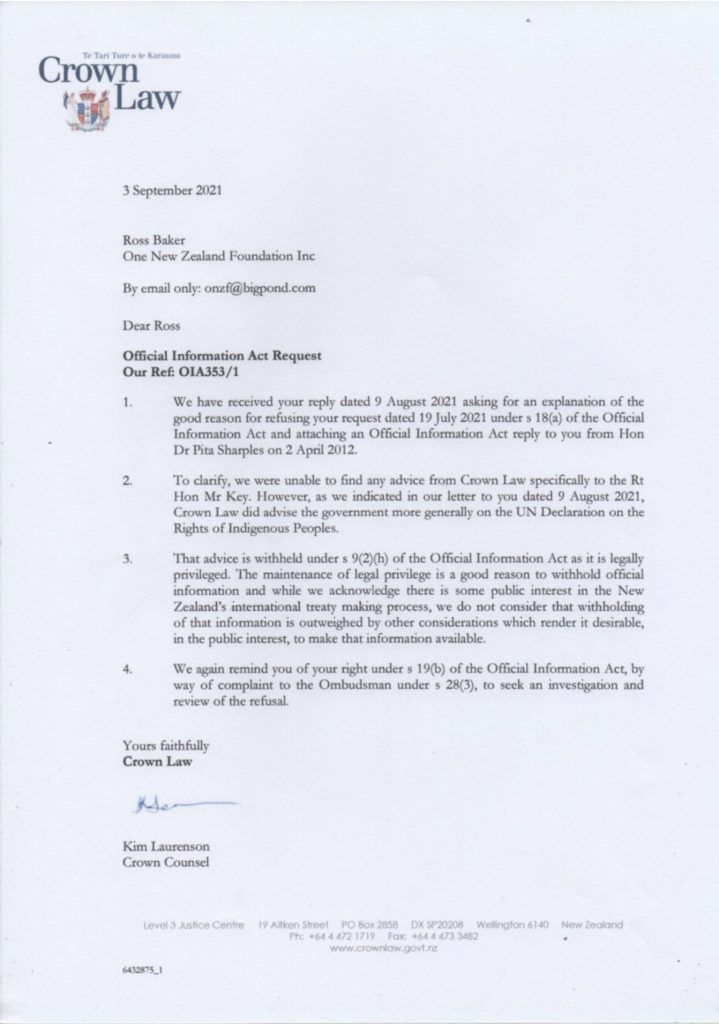 ‘
‘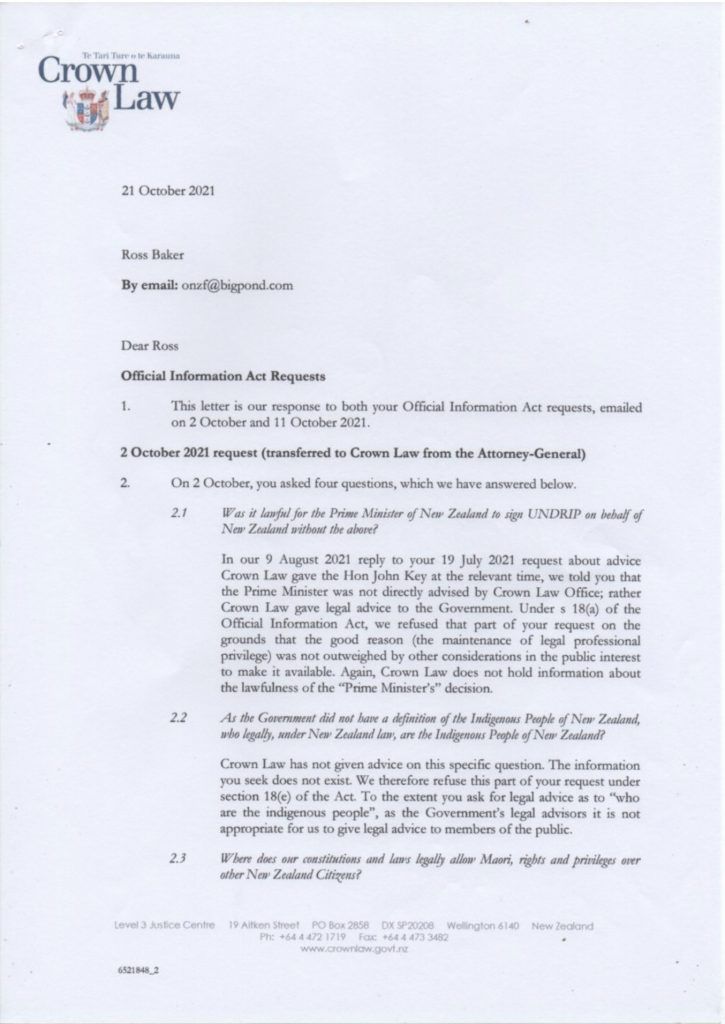
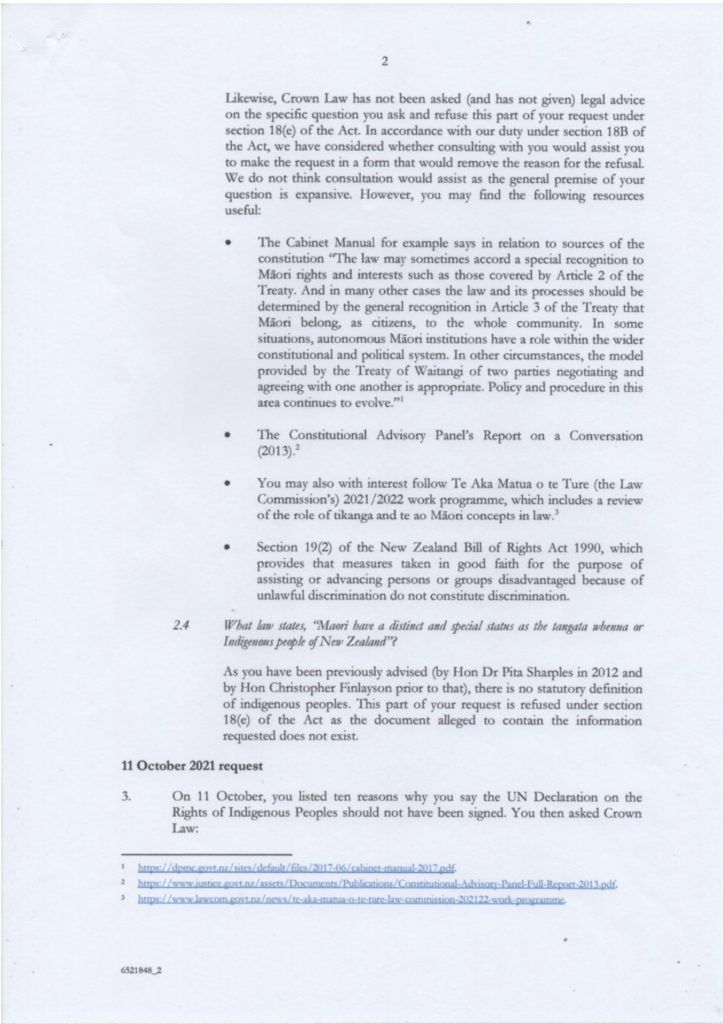 ‘
‘